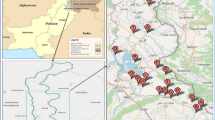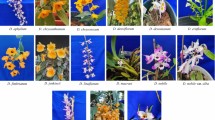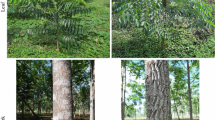Abstract
Consensus chloroplast simple sequence repeat (ccSSR) makers were used to assess the genetic variation and genetic relationships of 80 accessions from 25 taxa of the genus Avena. Fifteen out of 16 ccSSR markers (93.75%) were polymorphic. A total of 51 alleles were detected at the 16 ccSSR loci. The number of alleles per locus ranged from 1 to 6, with an average of 3.2 alleles. Among these ccSSR loci, the highest polymorphism information content (PIC) value was 0.754, while the lowest PIC value was 0. The mean genetic similarity index among the 80 Avena accessions was 0.545, ranging from 0.188 to 1.000. To assess the usefulness of ccSSRs in separating and distinguishing between haplome (genome) groups, we used ordination by canonical discriminant analysis and classificatory discriminant analysis. Although discriminant analysis separated the haplome groups unequivocally, it was up to 69% predictive of correctly classifying an individual plant whose haplome(s) is unknown in the case where it belonged to the A haplome group, 75% where it belonged in the AC group, and almost 80% where it belonged in the ACD group. The analysis of genetic similarity showed that diploid species with the A haplome were more diverse than other species, and that the species with the As haplome were more divergent than other diploid species with the A haplome. Among the species with the C haplome, A. clauda was more diverse than A. eriantha and A. ventricosa. In the cluster analysis, we found that the Avena accessions with the same genomes and/or belonging to the same species had the tendency to cluster together. As for the maternal donors of polyploid species based on this maternally inherited marker, A. strigosa served as the maternal donor of some Avena polyploidy species such as A. sativa, A. sterilis and A. occidentalis from Morocco. A. fatua is genetically distinct from other hexaploid Avena species, and A. damascena might be the A genome donor of A. fatua. Avena lusitanica served as the maternal parents during the polyploid formation of the AACC tetraploids and some AACCDD hexaploids. These results suggested that different diploid species were the putative A haplome donors of the tetraploid and hexaploid species. The C genome species A. eriantha and A. ventricosa are largely differentiated from the Avena species containing the A, or B, or D haplomes, whereas A. clauda from different accessions were found to be scattered within different groups.



Similar content being viewed by others
References
Alicchio R, Aranci L, Conte L (1995) Restriction fragment length polymorphism based phylogenetic analysis of Avena L. Genome 38:1279–1284
Anderson JC, Churchill GA, Autrique JE, Tanksley SD, Sorrells ME (1993) Optimizing parental selection for genetic linkage maps. Genome 36:181–186. doi:10.1139/g93-024
Baum BR (1977) Oats: wild and cultivated. a monograph of the genus Avena L. (Poaceae). Minister of Supply and Services Canada, Ottawa, Canada, 463 pp
Baum BR, Fedak G (1985) Avena atlantica, a new diploid species of the oat genus from Morocco. Can J Bot 63:1057–1060. doi:10.1139/b85-144
Baum BR, Johnson DA (1994) The molecular diversity of the 5S rRNA gene in barley (H. vulgare). Genome 37:992–998. doi:10.1139/g94-140
Baum BR, Johnson DA (1996) The 5S rRNA gene units in ancestral two-rowed barley (Hordeum spontaneum C. Koch) and bulbous barley (H. bulbosum L.): sequence analysis and phylogenetic relationships with the 5S rDNA units in cultivated barley (H. vulgare L.). Genome 39:140–149. doi:10.1139/g96-019
Baum BR, Johnson DA (1998) The 5S rRNA gene units in sea barley (Hordeum marinum Hudson sensu lato): sequence variation among repeat units and relationship to the X haplome in barley (Hordeum). Genome 41:652–661. doi:10.1139/gen-41-5-652
Baum BR, Johnson DA (1999) The 5S rRNA gene units in wall barley (Hordeum murinum L. sensu lato): sequence variation among repeat units and relationship to the Y haplome in the genus Hordeum (Poaceae: Triticeae). Genome 42:854–866. doi:10.1139/gen-42-5-854
Baum BR, Johnson DA (2000) The 5S rRNA gene units in the native New World annual Hordeum species (Triticeae: Poaceae). Can J Bot 78:1590–1602. doi:10.1139/cjb-78-12-1590
Baum BR, Johnson DA (2002) A comparison of the 5S rDNA diversity in the Hordeum brachyantherum-californicum complex with those of the eastern Asiatic Hordeum roshevitzii and the South Asiatic Hordeum cordobense (Triticeae: Poaceae). Can J Bot 80:752–762. doi:10.1139/b02-057
Baum BR, Johnson DA, Bailey LG (2001) Defining orthologous groups among multicopy genes prior to inferring phylogeny, with special emphasis on the Triticeae (Poaceae). Hereditas 135:123–138. doi:10.1111/j.1601-5223.2001.00123.x
Buchannan FC, Adams LJ, Littlejohn RP, Maddox JF, Crawford AM (1994) Determination of evolutionary relationships among sheep breeds using microsatellites. Genomics 22:397–403. doi:10.1006/geno.1994.1401
Chen Q, Armstrong K (1994) Genomic in situ hybridization in Avena sativa L. Genome 37:607–612. doi:10.1139/g94-086
Chen X, Cho YG, McCouch SR (2002) Microsatellites in Oryza and other plant species. Mol Genet Genomics 268:331–343. doi:10.1007/s00438-002-0739-5
Cheng YP, Hwang SY, Lin TP (2005) Potential refugia in Taiwan revealed by the phylogeographical study of Castanopsis carlesii Hayata (Fagaceae). Mol Ecol 14:2075–2085. doi:10.1111/j.1365-294X.2005.02567.x
Chung SM, Staub JE (2003) The development and evaluation of consensus chloroplast SSRs for chloroplast genetic analysis. Theor Appl Genet 107:757–767. doi:10.1007/s00122-003-1311-3
Clegg MT, Gaut BS, Learn GH, Morton RR (1994) Rates and pattern of chloroplast DNA evolution. Proc Natl Acad Sci USA 91:6795–6801. doi:10.1073/pnas.91.15.6795
Cochrane WG, Hopkins CE (1961) Some classification problems with multivariate qualitative data. Biometrics 17:10–32. doi:10.2307/2527493
Drossou A, Katsiotis A, Leggett JM, Loukas M, Tsakas S (2004) Genome and species relationships in genus Avena based on RAPD and AFLP molecular markers. Theor Appl Genet 109:48–54. doi:10.1007/s00122-004-1615-y
Dumolin S, Demesure B, Petit RJ (1995) Inheritance of chloroplast and mitochondrial genomes in pedunculate oak investigated with an efficient PCR method. Theor Appl Genet 91:1253–1256. doi:10.1007/BF00220937
Ennos RA, Sinclair WT, Hu XS, Langdon A (1999) Using organelle markers to elucidate the history, ecology and evolution of plant populations. In: Hollingsworth PM, Bateman RM, Gornall RJ (eds) Molecular systematics and plant evolution of plant populations. Taylor & Francis Ltd., London, pp 1–19
Fabijanski S, Fedak G, Armstrong K, Altosaar I (1990) A repeated sequence probe for the C genome in Avena (oat). Theor Appl Genet 79:1–7. doi:10.1007/BF00223778
Fahima T, Röder MS, Grama A, Nevo E (1998) Microsatellite DNA polymorphism divergence in Triticum dicoccoides accessions highly resistant to yellow rust. Theor Appl Genet 96:187–195. doi:10.1007/s001220050726
Fahima T, Röder MS, Wendehake K, Kirzhner VM, Nevo E (2002) Microsatellite polymorphism in natural populations of wild emmer wheat, Triticum dicoccoides, in Israel. Theor Appl Genet 104:17–29. doi:10.1007/s001220200002
Flannery ML, Mitchell FJG, Coyne S, Kavanagh TA, Bruke JI, Salamin N et al (2006) Plastid genome characterization in Brassica and Brassicaceae using a new set of nine SSRs. Theor Appl Genet 113:1221–1231. doi:10.1007/s00122-006-0377-0
Fominaya A, Vega C, Ferrer E (1988) C-banding and nucleolar activity of tetraploid Avena species. Genome 30:633–638
Gao LF, Tang JF, Li HW, Jia JZ (2003) Analysis of microsatellites in major crops assessed by computational and experimental approaches. Mol Breed 12:245–261. doi:10.1023/A:1026346121217
Gilbert ES (1968) On discrimination using qualitative variables. J Am Stat Assoc 63:1399–1412. doi:10.2307/2285893
Gupta PK, Gibaud M, Altosaar I (1992) Two molecular probes characterizing the A and C genomes in the genus Avena (oats). Genome 35:916–920
Gupta PK, Balyan HS, Edwarda KJ, Isaac P, Korzun V, Röder MS et al (2002) Genetic mapping of 66 new microsatellite (SSR) loci in bread wheat. Theor Appl Genet 105:413–422. doi:10.1007/s00122-002-0865-9
Huang XQ, Börner AB, Röder MS, Ganal MW (2002) Assessing genetic diversity of wheat (Triticum aestivum L.) germplasm using microsatellite markers. Theor Appl Genet 105:699–707. doi:10.1007/s00122-002-0959-4
Irigoyen ML, Linares C, Ferrer E, Fominaya A (2002) Fluorescence in situ hybridization mapping of Avena sativa L. cv. SunII and its monosomic lines using cloned repetitive DNA sequences. Genome 45:1230–1237. doi:10.1139/g02-076
Jellen EN, Phillips RL, Rines HW (1993) C-banded karyotypes and polymorphisms in hexaploid oat accessions (Avena spp.) using Wright’s stain. Genome 36:1129–1137. doi:10.1139/g93-151
Jellen EN, Gill BS, Cox TS (1994) Genomic in situ hybridization differentiates between A/D- and C-genome chromatin and detects intergenomic translocations in polyploid oat species (genus Avena). Genome 37:613–618. doi:10.1139/g94-087
Krzanowski WJ (1975) Discrimination and classification using both binary and continuous variables. J Am Stat Assoc 70:782–790. doi:10.2307/2285437
Kshirsagar AM (1972) Multivariate analysis. Marcel Dekker, New York
Lachenbruch PA, Mickey MA (1968) Estimation of error rates in discriminant analysis. Technometrics 10:1–10. doi:10.2307/1266219
Ladizinsky G (1973) The cytogenetic position of Avena prostrata among the diploid oats. Can J Genet Cytol 15:443–450
Ladizinsky G (1998) A new species of Avena from Sicily, possibly the tetraploid progenitor of hexaploid oats. Genet Resour Crop Evol 45:263–269. doi:10.1023/A:1008657530466
Ladizinsky G, Fainstein R (1977) Intergression between the cultivated hexaploid oat A. sativa and the tetraploid wild A. magna and A. murphyi. Can J Genet Cytol 19:59–60
Ladizinsky G, Zohary D (1971) Notes on species delimitation, species relationships and polyploidy in Avena. Euphytica 20:380–395. doi:10.1007/BF00035663
Leggett JM (1984) Morphology and metaphase chromosome pairing in three Avena hybrids. Can J Genet Cytol 26:641–645
Leggett JM (1992) Oat science and technology. Agronomy monograph, no. 33. American Society of Agronomy and Crop Science Society of America, St. Louis, pp 29–52
Leggett JM, Markhand GS (1995a) The genomic structure of Avena revealed by GISH. In: Brandham P, Bennett MD (eds) Kew chromosome conference IV, Royal Botanic Gardens, Kew UK, pp 133–139
Leggett JM, Markhand GS (1995b) The genomic identification of some monosomics of Avena sativa L. cv. Sun II using genomic in situ hybridization. Genome 38:747–751. doi:10.1139/g95-094
Li CD, Rossnagel BG, Scoles GJ (2000) The development of oat microsatellite markers and their use in identifying relationships among Avena species and oat cultivars. Theor Appl Genet 101:1259–1268. doi:10.1007/s001220051605
Linares C, Vega C, Ferrer E, Fominaya A (1992) Identification of C-banded chromosomes in meiosis and the analysis of nucleolar activity in Avena byzantina C. Koch cv. ‘Kanota’. Theor Appl Genet 83:650–654. doi:10.1007/BF00226911
Linares C, Gonzalez J, Ferrer E, Fominaya A (1996) The use of double FISH to physically map the positions of 5S rDNA genes in relation to the chromosomal location of 18S-5.8S-26S rDNA and a C genome specific DNA sequence in the genus Avena. Genome 39:535–542. doi:10.1139/g96-068
Liu XM, Smith CM, Gill BS (2002) Identification of microsatellite markers linked to Russian wheat aphid resistance genes Dn4 and Dn6. Theor Appl Genet 104:1042–1048. doi:10.1007/s00122-001-0831-y
Loudet O, Chaillou S, Camilleri C, Bouchez D, DanielVedele F (2002) Bay-0 × Shahdara recombinant inbred line population: a powerful tool for the genetic dissection of complex traits in Arabidopsis. Theor Appl Genet 104:1173–1184. doi:10.1007/s00122-001-0825-9
Ma XF, Wanous MK, Houchins K, Rodriguezmila MA, Goicoechea PG, Wang Z et al (2001) Molecular linkage mapping in rye (Secale cereale L.). Theor Appl Genet 102:517–523. doi:10.1007/s001220051676
Matsuoka Y, Mitchell SE, Kresovich S, Goodman M, Doebley J (2002) Microsatellite in Zea-variability, patterns of mutations, and use for evolutionary studies. Theor Appl Genet 104:436–450. doi:10.1007/s001220100694
McCauley DE (1994) Contrasting the distribution of chloroplast DNA and allozyme polymorphism among local populations of Silene alba: implications for studies of gene flow in plants. Proc Natl Acad Sci USA 91:8127–8131. doi:10.1073/pnas.91.17.8127
Mogensen HL (1996) The hows and whys of cytoplasmic inheritance in seed plants. Am J Bot 83:383–404. doi:10.2307/2446172
Murai K, Tsunewaki K (1986) Phylogenetic relationship between Avena species revealed by the restriction endonuclease analysis of chloroplast and mitochondrial DNAs. In: Lawes DA, Thomas H (eds) Proceedings of the 2nd international oats conference. Martinus Nijhoff, Dordrecht, pp 34–38
Murai K, Tsunewaki K (1987) Chloroplast genome evolution in the genus Avena. Genetics 116:613–621
Nei M (1973) Analysis of gene diversity in subdivided populations. Proc Natl Acad Sci USA 70:3321–3323. doi:10.1073/pnas.70.12.3321
Nei M, Li WH (1979) Mathematical model for studying genetic variation in terms of restriction endonucleases. Proc Natl Acad Sci USA 76:5269–5273. doi:10.1073/pnas.76.10.5269
Nishiyama I (1984) Climate influence on pollen formation and fertilization. In: Tsunoda S, Takahashi N (eds) Biology of rice. Elsevier, Amsterdam, pp 153–171
Nishiyama I, Yabuno T (1975) Meiotic chromosome pairing in two interspecific hybrids and a criticism of the evolutionary relationship of diploid Avena Jap. J Genet 50:443–451
Nocelli E, Giovannini T, Bioni M, Alicchio R (1999) RFLP- and RAPD-based genetic relationships of seven diploid species of Avena with the A genome. Genome 42:950–959. doi:10.1139/gen-42-5-950
Olmstead RG, Palmer JD (1994) Chloroplast DNA systematics: a review of methods and data analysis. Am J Bot 81:1205–1224. doi:10.2307/2445483
Panda S, Martin JP, Aguinagalde I (2003) Chloroplast and nuclear DNA studies in a few members of the Brassica oleracea L. group using PCR-RFLP and ISSR-PCR markers: a population genetic analysis. Theor Appl Genet 106:1122–1128
Peng YY, Wei YM, Baum BR, Zheng YL (2008) Molecular diversity of 5S rDNA gene and genomic relationships in genus Avena (Poaceae: Aveneae). Genome 51:137–154. doi:10.1139/G07-111
Powell W, Machray GC, Provan J (1996) Polymorphism revealed by simple sequence repeats. Trends Plant Sci 7:215–222
Provan J, Powell W, Hollingsworth PM (2001) Chloroplast microsatellites: new tools for studies in plant ecology and evolution. Trends Ecol Evol 16:142–147. doi:10.1016/S0169-5347(00)02097-8
Rajhathy T, Thomas H (1974) Cytogenetics of oats (Avena L.). Misc Publ Genet Soc Can 2:1–90
Rajora OP, Dancik BP (1992) Chloroplast DNA inheritance in Populus. Theor Appl Genet 84:280–285
Rao CR (1952) Advanced statistical methods in biometric research. Wiley, New York
Rendell S, Ennos RA (2003) Chloroplast DNA diversity of the dioecious European tree Ilex aquifolium L. (English holly). Mol Ecol 12:2681–2688. doi:10.1046/j.1365-294X.2003.01934.x
Rines HW, Gengenbach BG, Boylan KL (1988) Mitochondrial DNA diversity in oat cultivars and species. Crop Sci 28:171–176
Röder MS, Korzun V, Wendehake K, Plaschke J, Tixier MH, Leroy P et al (1998) A microsatellite map of wheat. Genetics 149:2007–2023
Rodionov AV, Tyupa NB, Kim ES, Machs EM, Loskutov IG (2005) Genomic configuration of the autotetraploid oat species Avena macrostachya inferred from comparative analysis of ITS1 and ITS2 sequences: on the oat karyotype evolution during the early events of the Avena species divergence. Russ J Genet 41(5):518–528. doi:10.1007/s11177-005-0120-y
Rohlf FJ (2002) NTSYS-pc. Numerical taxonomy and multivariate analysis system, Version 2.1. Exeter Software, New York
Roselyne L, Mathieu TD, Henri M, Aurélie S, Emilie I, Céline B et al (2005) Phylogeographical variation of chloroplast DNA in Cork Oak (Quercus suber). Ann Bot (Lond) 96:853–861. doi:10.1093/aob/mci237
Sambrook J, Fritsch EF, Maniatis T (1989) Molecular cloning: a laboratory manual. Cold Spring Harbor Laboratory Press, New York
Sanguinelti CJ, Neto ED, Simpson AJG (1994) Rapid silver staining and recovery of PCR products separated on polyacrylamide gels. Biotechniques 17:915–919
SAS Institute Inc. (1989) SAS/STAT User’s Guide, Version 6, vol 2, 4th edn. SAS Institute Inc., Cary, NC
Scholz H (1991) The systematics of Avena sterilis and A. fatua (Gramineae): a critical study. Willdenovia 20:103–112
Shang HY, Baum BR, Wei YM, Zheng YL (2007) The 5S rRNA gene diversity in the genus Secale and determination of its closest haplomes. Genet Resour Crop Evol 54:793–806. doi:10.1007/s10722-006-9149-6
Shelukhina OY, Badaeva ED, Loskutov IG, Pukhal’sky VA (2007) A comparative cytogenetic study of the tetraploid oat species with the A and C genomes: A. insularis, A. maroccana and A. murphyi. Russ J Genet 43:613–626. doi:10.1134/S102279540706004X
Soltis DE, Soltis PS, Milligan BG (1992) Intraspecific cpDNA variation: systematic and phylogenetic implications. In: Soltis PS, Soltis DE, Doyle JJ (eds) Molecular systematics of plants. Chapman & Hall, New York, pp 117–150
Stephenson P, Bryan G, Kirby J, Collins A, Devos K, Busso C et al (1998) Fifty new microsatellite loci for the wheat genetic map. Theor Appl Genet 97:946–949. doi:10.1007/s001220050975
Thomas H (1992) Cytogenetics of Avena. In: Marshall HG, Sorrells ME (eds) Oat science and technology. American Society of Agronomy Inc. and Crop Science Society of America, Inc, Madison, pp 473–507
Walter R, Epperson BK (2001) Geographic pattern of genetic variation in Pinus resinosa: area of greatest diversity is not the origin of postglacial populations. Mol Ecol 10:103–111. doi:10.1046/j.1365-294X.2001.01177.x
Yang Q, Hanson L, Bennett MD, Leitch IJ (1999) Genome structure and evolution in the allohexaploid weed Avena fatua L. (Poaceae). Genome 42:512–518. doi:10.1139/gen-42-3-512
Yeh FC, Yang RC, Boyle T (1999) PopGene Version 1.31. Microsoft Window-based freeware for population genetic analysis. Quick user guide. http://www.ualberta.ca/~fyeh/
Acknowledgements
We thank the Agriculture & Agri-Food Canada (AAFC) and the National Small Grains Collection, ARS, USDA, for kindly providing the Avena material. We are grateful to Mrs. Charlene Wight, Agriculture & Agri-Food Canada, Ottawa, Canada, for many mostly editorial changes that have improved the manuscript. This work was supported by the National High Technology Research and Development Program of China (863 program 2006AA10Z179 and 2006AA10Z1F8) and the FANEDD project (200357 and 200458) of the Ministry of Education, China. Dr. Y.-M. Wei was supported by the Program for New Century Excellent Talents in Universities of China (NCET-05-0814).
Author information
Authors and Affiliations
Corresponding authors
Additional information
Wei-Tao Li and Yuan-Ying Peng have contributed equally to this paper.
Rights and permissions
About this article
Cite this article
Li, WT., Peng, YY., Wei, YM. et al. Relationships among Avena species as revealed by consensus chloroplast simple sequence repeat (ccSSR) markers. Genet Resour Crop Evol 56, 465–480 (2009). https://doi.org/10.1007/s10722-008-9379-x
Received:
Accepted:
Published:
Issue Date:
DOI: https://doi.org/10.1007/s10722-008-9379-x




